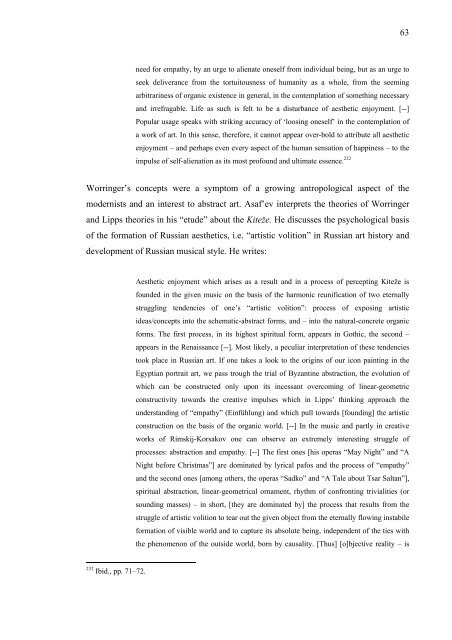Boris Asaf'ev and the Soviet Musicology - E-thesis
Boris Asaf'ev and the Soviet Musicology - E-thesis
Boris Asaf'ev and the Soviet Musicology - E-thesis
You also want an ePaper? Increase the reach of your titles
YUMPU automatically turns print PDFs into web optimized ePapers that Google loves.
need for empathy, by an urge to alienate oneself from individual being, but as an urge to<br />
seek deliverance from <strong>the</strong> tortuitousness of humanity as a whole, from <strong>the</strong> seeming<br />
arbitrariness of organic existence in general, in <strong>the</strong> contemplation of something necessary<br />
<strong>and</strong> irrefragable. Life as such is felt to be a disturbance of aes<strong>the</strong>tic enjoyment. [--]<br />
Popular usage speaks with striking accuracy of ‘loosing oneself’ in <strong>the</strong> contemplation of<br />
a work of art. In this sense, <strong>the</strong>refore, it cannot appear over-bold to attribute all aes<strong>the</strong>tic<br />
enjoyment – <strong>and</strong> perhaps even every aspect of <strong>the</strong> human sensation of happiness – to <strong>the</strong><br />
impulse of self-alienation as its most profound <strong>and</strong> ultimate essence. 232<br />
Worringer’s concepts were a symptom of a growing antropological aspect of <strong>the</strong><br />
modernists <strong>and</strong> an interest to abstract art. Asaf’ev interprets <strong>the</strong> <strong>the</strong>ories of Worringer<br />
<strong>and</strong> Lipps <strong>the</strong>ories in his “etude” about <strong>the</strong> Kiteže. He discusses <strong>the</strong> psychological basis<br />
of <strong>the</strong> formation of Russian aes<strong>the</strong>tics, i.e. “artistic volition” in Russian art history <strong>and</strong><br />
development of Russian musical style. He writes:<br />
232 Ibid., pp. 71–72.<br />
Aes<strong>the</strong>tic enjoyment which arises as a result <strong>and</strong> in a process of percepting Kiteže is<br />
founded in <strong>the</strong> given music on <strong>the</strong> basis of <strong>the</strong> harmonic reunification of two eternally<br />
struggling tendencies of one’s “artistic volition”: process of exposing artistic<br />
ideas/concepts into <strong>the</strong> schematic-abstract forms, <strong>and</strong> – into <strong>the</strong> natural-concrete organic<br />
forms. The first process, in its highest spiritual form, appears in Gothic, <strong>the</strong> second –<br />
appears in <strong>the</strong> Renaissance [--]. Most likely, a peculiar interpretation of <strong>the</strong>se tendencies<br />
took place in Russian art. If one takes a look to <strong>the</strong> origins of our icon painting in <strong>the</strong><br />
Egyptian portrait art, we pass trough <strong>the</strong> trial of Byzantine abstraction, <strong>the</strong> evolution of<br />
which can be constructed only upon its incessant overcoming of linear-geometric<br />
constructivity towards <strong>the</strong> creative impulses which in Lipps’ thinking approach <strong>the</strong><br />
underst<strong>and</strong>ing of “empathy” (Einfühlung) <strong>and</strong> which pull towards [founding] <strong>the</strong> artistic<br />
construction on <strong>the</strong> basis of <strong>the</strong> organic world. [--] In <strong>the</strong> music <strong>and</strong> partly in creative<br />
works of Rimskij-Korsakov one can observe an extremely interesting struggle of<br />
processes: abstraction <strong>and</strong> empathy. [--] The first ones [his operas “May Night” <strong>and</strong> “A<br />
Night before Christmas”] are dominated by lyrical pafos <strong>and</strong> <strong>the</strong> process of “empathy”<br />
<strong>and</strong> <strong>the</strong> second ones [among o<strong>the</strong>rs, <strong>the</strong> operas “Sadko” <strong>and</strong> “A Tale about Tsar Saltan”],<br />
spiritual abstraction, linear-geometrical ornament, rhythm of confronting trivialities (or<br />
sounding masses) – in short, [<strong>the</strong>y are dominated by] <strong>the</strong> process that results from <strong>the</strong><br />
struggle of artistic volition to tear out <strong>the</strong> given object from <strong>the</strong> eternally flowing instabile<br />
formation of visible world <strong>and</strong> to capture its absolute being, independent of <strong>the</strong> ties with<br />
<strong>the</strong> phenomenon of <strong>the</strong> outside world, born by causality. [Thus] [o]bjective reality – is<br />
63

















